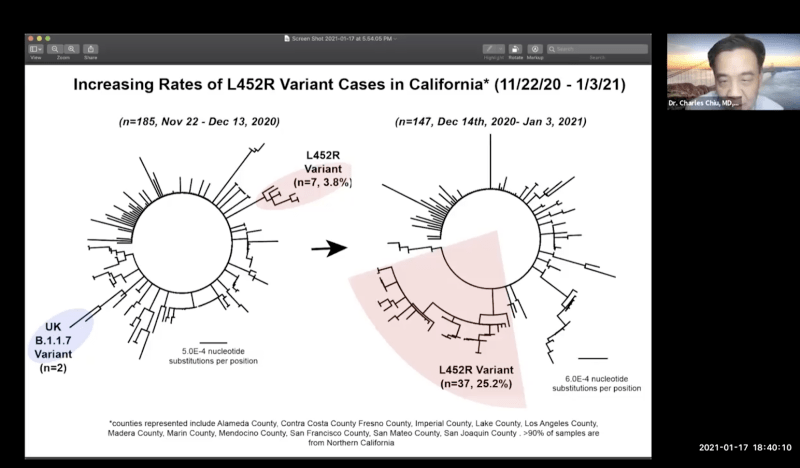A new COVID-19 variant is linked to several large outbreaks in Santa Clara County, including one in the Kaiser San Jose Medical Center, according to an announcement from health officials on Jan. 17.
The variant, known as 452R, is different from the rapidly spreading strain in the United Kingdom and has now been observed in 12 counties across California. First detected in Denmark in March and later in Alameda County in May, the Centers for Disease Control and Prevention has now reported 88 cases of the variant in the United States, 40 of which are in California.
According to Benjamin Pinsky, associate professor of pathology and of infectious diseases at the School of Medicine and medical director of the Stanford Clinical Virology Laboratory, Stanford Medicine has observed an increase in the number of cases with the variant.
“There is concern that this variant may be more transmissible, given its association with the Santa Clara outbreaks,” Pinsky wrote in an email to The Daily. “We do not know yet, however, whether this variant is more transmissible, nor do we have enough information regarding its impact on disease severity or vaccine efficacy.”
Phillip Grant, principal investigator of the Johnson & Johnson vaccine trial at Stanford, wrote in an email to The Daily that because “the prevalence of this variant is increasing,” the variant “may be … more infectious.”
Santa Clara County public health officer Sara Cody confirmed during the Santa Clara Public Health Department press conference on Jan. 17 that the variant was identified in an outbreak at Kaiser Permanente San Jose Medical Center involving at least 15 patient and 77 staff infections. According to The New York Times, an employee dressed as an air-powered tree likely spread coronavirus-laden droplets throughout the emergency department on Christmas, leading to the increase in cases and the death of one registration clerk.
The news underscores the need for people to follow social distancing measures and get vaccinated as soon as they can, Cody added.
“The fact that this variant was identified in several large outbreaks in our county is a red flag and must be investigated further,” Cody said in a statement at the press conference. “This virus continues to mutate and adapt, and we cannot let down our guard.”
The 452R variant was “uncommon prior to early December” but now accounts for “roughly 25% of cases” detected by genomic sequencing in the lab of UCSF virologist and professor of laboratory medicine Dr. Charles Chiu, according to a statement during the press conference. As part of the state’s COVID-NET initiative aiming to rapidly identify new variants of COVID-19, Chiu has been sequencing cases from multiple counties for the last several months.
Chiu cautioned that the true prevalence of the variant remains unclear due to the state’s lack of a systematic genomic surveillance program, as “the selected specimens, the sequenced volume, and the representation of various counties can definitely be biased.” The rising proportion of the cases across urban and rural counties raises concerns about the transmissibility of the virus, although “formal epidemiological investigation” needs to be done.
The new variant could also have an impact on vaccinations, though more research is needed.
“In terms of vaccine efficacy this is to be determined but the concern is valid,” Grant wrote. “It is possible that future vaccines will include more than one variant but should not have a big short term effect.”
Contact Jodie Meng at jomeng ‘at’ stanford.edu.
